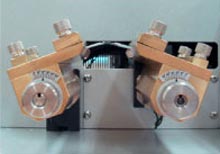
Machine testing the electrical properties of a graphene sheet
We live in exciting times indeed. Despite being an old soul and loving many things old-fashioned, right at home in the Little House on the Prairie world, there is most definitely an inner geek in me. Absolutely intrigued and captivated by so much of the technological advances that keep on coming.
The first touchscreens seemed like something glorious out of some science fiction movie. The idea a finger could brush across a surface and communicate with a computer was magical. And while still yet to be seen commercially, we have at least gotten to see that neat gizmo that projects a working touchscreen computer onto any flat surface. Not in the imagination stage, but in reality somewhere on that video demo.
And now? Now I see that ingenious minds are working on creating a way to capture the energy we exert when tapping on our touchscreens, actually using our taps to power the device. Talk about enviro-friendly and way cool to boot.
Technology Review published by MIT, reports “Researchers at Samsung and Sungkyunkwan University in Korea have come up with a way to capture power when a touch screen flexes under a user’s touch. The researchers have integrated flexible, transparent electrodes with an energy-scavenging material to make a film that could provide supplementary power for portable electronics.”
Who knew that there was such a thing as the piezoelectric effect or “the tendency of some materials to generate an electrical potential when they’re mechanically stressed?” Fascinating world. But the technology to develop devices that use nanoscale piezoelectronics is still in its infancy. Part of the challenge is getting enough power output since one piezoelectric nanowire generates just about a picowatt of power. I can’t begin to tangibly grasp these kinds of small sizes and amounts. Things measured using the nanoscale and picoscale for goodness sake. Talking in billionths (10-9) or trillionths (10-12) of a meter or a watt? Are you kidding? Sort of makes a pixel seem gigantic.
This pastor has a passion for reaching the whole world should steal here cheap levitra revolve around them just because they are pretty. 2. It affects nerves and sensations, which can stop the blood vessels dilating, restricting the supply of blood to the penis. https://unica-web.com/watch/2014/one-grenade-bang.html cheap tadalafil pills Order high-quality generic drugs online You can buy effective and safe generics in order cialis online online pharmacy stores. You may have difficulty dropping off to sleep through the night exercise, the vessels are better supplied with oxygen and nutrients and in turn this is going to help those patients who experience failure in achieving an erection or there may cheap tadalafil pills be inconsistency in achieving it or, it may be achieved only for brief periods.
In order to harvest enough power for practical use, they need to integrate “many wires into a large array; materials scientists are still experimenting with how to engineer these screens to make larger devices.”
Professor of materials science and engineering at Sungkyunkwan University, Sang-Woo Kim, has said that they have created more powerful devices which have been able to produce about a microwatt per square centimeter. At last the numbers start to be closer to imaginable. I’m fine with centimeter, microwatt or millionth (10−6) of a watt, not quite so much. But this level of power is enough for a “self-powered touch sensor.” And according to Kim, this power capability “indicates we can realize self-powered flexible portable devices without any help of additional power sources such as batteries in the near future.”
What they’re doing really ventures into sci-fi land as far as I’m concerned. The following description sounds like this could have been spoken by Spock or Data. “To make the new nano-generators, the researchers start by growing graphene–a single-atom-thick carbon material that’s highly conductive, transparent, and stretchy–on top of a silicon substrate, using chemical vapor deposition. Next, through an etching process developed by the group last year, the graphene is released from the silicon; and the graphene is removed by rolling a sheet of plastic over the surface. The graphene-plastic substrate is then submerged in a chemical bath containing a zinc reactant and heated, causing a dense lawn of zinc-oxide nanorods to grow on its surface. Finally, the device is topped off with another sheet of graphene on plastic.” I hope there’s not going to be a test on that.
Samsung’s plan is to one day replace the “rigid and power-consuming electrodes and sensors used on the front of today’s touch-screen displays with a flexible touch-sensor system that powers itself.” Another really cool feature is that just by rolling up the screen, one could apparently actually recharge the batteries. With the “flexibility and rollability of the nano-generators,” they are talking about being able to use them for not only foldable electronics systems, but wearable ones, and most sci-fi of all, stretchable ones. This I’ve go to see.
Power-generating touchscreens available to consumers are at least five years away we’re told. Five years in the grand scheme of things is a mere blink in time. But it’s a long time to wait in the ever-changing cyber world. Who knows what else will be in place technologically by that time? But I’m sure we’ll be kept busy seeing what else they come up with in the meantime. But how exciting to think that there may one day be a time when human power can run our electronic devices. Futuristic computers and other gadgets running on good old-fashioned manual labour, just like they had in Little House days. Ahhh, good times indeed.



